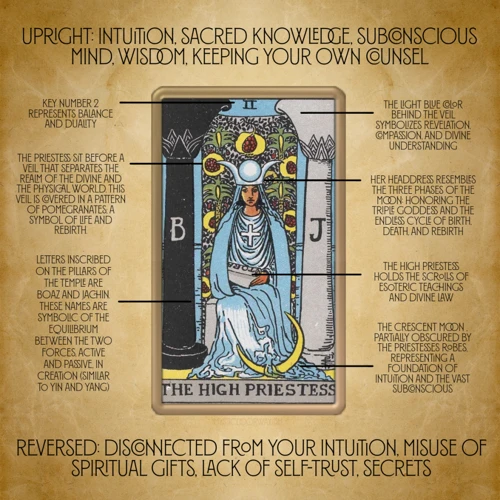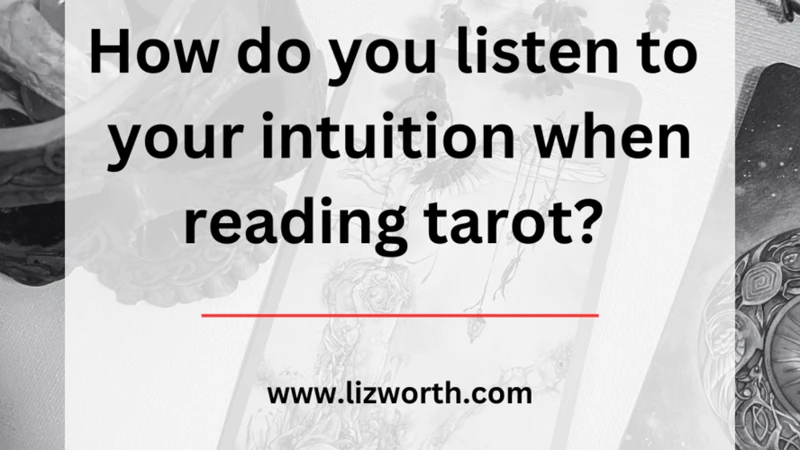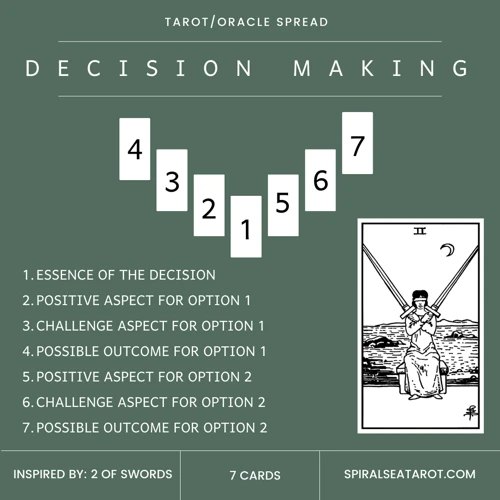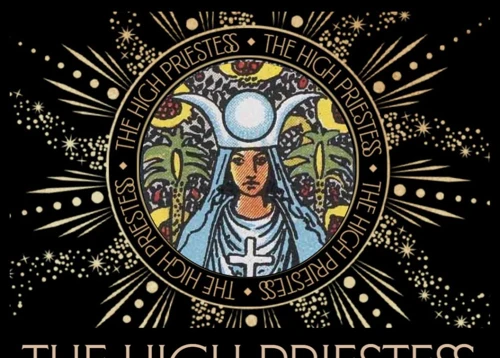Welcome to the world of tarot cards, where ancient symbolism and intuition come together to provide guidance and insight. In this article, we delve into the mysteries of the High Priestess card, exploring its meaning and the powerful connection it holds to our intuitive nature. Through understanding the symbolism of this enigmatic card and learning how to develop and harness our intuition, we can tap into our inner wisdom and make better decisions. Join us as we explore the depths of the High Priestess card and learn how to unlock the power of our intuition.
Contents
- Understanding The High Priestess Card
- Developing Intuition
- Applying Intuition in Decision Making
- The High Priestess and Personal Growth
- Conclusion
-
Frequently Asked Questions
- What does the High Priestess card represent in tarot?
- What is the symbolism of the seated figure in the High Priestess card?
- How can I develop my intuition?
- Can anyone tap into their intuition?
- How can I differentiate between intuition and logical thinking?
- Should I always trust my intuition?
- Can tarot cards really help with decision making?
- How does the High Priestess card relate to personal growth?
- Is the High Priestess card associated with spirituality?
- Can the High Priestess card predict the future?
- References
Understanding The High Priestess Card

The High Priestess card is a mysterious and intriguing archetype in the tarot deck, representing deep intuition, inner knowing, and esoteric wisdom. Associated with the divine feminine energy and the moon, this card holds a profound meaning for those seeking to tap into their psychic abilities and harness their intuitive powers. Symbolized by a seated figure between two pillars, the High Priestess signifies the realm of the subconscious and the hidden aspects of the self, inviting us to explore the depths of our intuition and connect with our inner truths. By understanding the symbolism and significance of the High Priestess card, we can unlock the secrets of our intuition and embark on a journey of self-discovery and spiritual growth.
Meaning and Symbolism
The High Priestess card holds deep meaning and symbolism within the realm of tarot. Depicted as a woman seated between two pillars, she represents the realm of intuition, divine knowledge, and spiritual wisdom. The pillars on either side of her symbolize the duality of life, with one pillar representing darkness and the other representing light. This signifies the High Priestess’s ability to navigate the hidden realms of the subconscious and bring forth deep insights. She is often associated with the moon, which further emphasizes her connection to the intuitive and mysterious aspects of life.
The High Priestess also holds a scroll or book of knowledge in her lap, representing the sacred knowledge and ancient wisdom that she possesses. This indicates the importance of seeking inner wisdom and tapping into our own intuition when making decisions. By connecting with our intuitive selves, we can access a deeper level of understanding and make choices that align with our true path.
The veil behind the High Priestess symbolizes the hidden truths and mysteries that she guards. It reminds us that tapping into our intuition requires peeling away the layers of illusion and allowing ourselves to see beyond the surface. By doing so, we can gain clarity and guidance in our decision-making processes. The High Priestess’s white garment represents purity and spiritual enlightenment, highlighting the need to approach life’s challenges with a clear and open mind.
In the tarot deck, the High Priestess is often associated with other cards that emphasize the importance of intuition and inner guidance. For example, the Wheel of Fortune card reminds us that embracing change is a crucial aspect of tapping into our intuition, while the Star card speaks to finding hope and inspiration through our intuitive inner voice. The High Priestess card serves as a powerful reminder that by embracing our intuition and symbolism, we can unlock the secrets of the universe and make decisions that align with our highest good.
Connection to Intuition
The High Priestess card is closely associated with intuition, serving as a gateway to our inner wisdom and subconscious mind. This card encourages us to trust our instincts and tap into our innate knowledge beyond logical reasoning. Just as the High Priestess sits between the pillars of knowledge and intuition, she reminds us of the importance of finding balance between our rational thoughts and our intuitive insights.
In a world that often values logic and reason above all else, the High Priestess card urges us to embrace our intuition as a valuable source of guidance. Intuition is the ability to understand something instinctively, without the need for conscious deliberation. It is that gut feeling, that inner voice that whispers to us in moments of decision-making. When we connect to our intuition, we tap into a deeper understanding of ourselves and the world around us.
In the tarot, the High Priestess is often associated with the moon, which represents the realm of emotions and the hidden depths of our psyche. This connection highlights the role of intuition in uncovering hidden truths and gaining insights that go beyond what can be perceived on the surface. By developing a strong connection to our intuition, we can navigate life with greater discernment and make decisions that align with our truest selves.
To strengthen our bond with our intuition, it is important to cultivate practices that invite introspection and self-reflection. This can include meditation, journaling, or simply taking quiet moments to tune in to our inner voice. The High Priestess card reminds us that by embracing our intuition, we open ourselves up to a wealth of wisdom and guidance that can enrich our lives and lead us towards our highest potential.
Developing Intuition

Developing intuition is a powerful journey of self-discovery and heightened awareness. There are various practices and exercises that can help cultivate and strengthen our intuitive abilities. One effective way to develop intuition is through meditation and mindfulness. Taking the time to quiet the mind and listen to our inner voice allows us to tap into our subconscious wisdom. Another approach is to keep a journal and write down our intuitive insights, dreams, and synchronicities. This helps us recognize patterns and connect the dots between our intuition and the choices we make. Additionally, surrounding ourselves with supportive and like-minded individuals can create an environment that nurtures and encourages our intuitive growth. By engaging in these practices and exercises, we can embrace our intuitive nature and make decisions that align with our inner wisdom.
Practices and Exercises
Practices and exercises are essential for developing and strengthening our intuition, and there are several techniques you can incorporate into your daily routine to enhance your intuitive abilities. One effective practice is meditation, which allows you to quiet the mind, connect with your inner self, and open up to intuitive insights. You can start by setting aside a few minutes each day to sit in a quiet space, close your eyes, and focus on your breath. As thoughts arise, acknowledge them and let them go, returning your attention to your breath. With regular practice, you’ll find that your intuition becomes clearer and more accessible.
Another exercise to cultivate intuition is journaling. Writing down your thoughts, feelings, and experiences can help you tap into your subconscious mind and uncover hidden insights. Set aside time each day to journal, allowing your thoughts to flow freely without judgment or analysis. Reflect on any recurring themes or patterns that emerge, as these may hold valuable guidance from your intuition.
In addition to meditation and journaling, you can also engage in activities that stimulate your senses and heighten your intuition. This can include spending time in nature, practicing mindfulness, or engaging in creative pursuits such as painting or playing an instrument. Allowing yourself to be present in the moment and fully immersed in these activities can help you tap into your intuitive knowing.
By incorporating these practices and exercises into your life, you can strengthen your intuition and develop a deeper connection with your inner wisdom. Remember, intuition is like a muscle that needs regular exercise to grow stronger, so make it a priority to dedicate time and energy to these practices.
Listening to Your Inner Voice
- Tune into your feelings: One of the first steps in listening to your inner voice is to pay attention to your emotions and gut instincts. Your intuition often communicates through subtle feelings, hunches, or a sense of knowing. Take the time to pause and tune into these sensations, allowing them to guide your decision-making process.
- Embrace solitude and silence: Creating moments of solitude and silence can help you quiet the noise of the outside world and connect with your inner voice. Find a quiet space where you can be alone with your thoughts and allow yourself to enter a state of introspection and reflection. In this solitude, you can hear the whispers of your intuition more clearly.
- Practice mindfulness: Mindfulness is the practice of being fully present in the current moment. By cultivating mindfulness, you become attuned to the signals and messages of your intuition. Engage in activities like meditation, deep breathing exercises, or mindful walking to develop a state of mindfulness and deepen your connection with your inner voice.
- Keep a journal: Writing in a journal is a powerful tool for self-reflection and accessing your inner voice. Set aside dedicated time each day to write down your thoughts, feelings, and any intuitive insights or guidance you receive. This process allows you to develop a stronger connection with your intuition and provides a record of your intuition’s wisdom over time.
Remember that listening to your inner voice is a practice that requires patience and trust. Sometimes the messages from your intuition may seem subtle or vague, but with time and practice, you will become more adept at deciphering and understanding them. Trusting your inner voice and following its guidance can lead to greater clarity, fulfillment, and alignment with your true self.
Applying Intuition in Decision Making

When it comes to decision-making, applying intuition can be a powerful tool. The High Priestess card reminds us to trust our inner voice and rely on our gut instincts. Trusting Your Gut is about tuning in to that deep sense of knowing and allowing it to guide us towards the best choice. Our intuition often picks up on subtle signals and cues that may not be apparent through logical analysis alone. It can provide a sense of clarity and direction that helps us navigate complex situations. However, it’s important to note that intuition should not be confused with impulsive or irrational decision-making. Instead, it taps into a deeper level of wisdom that takes into account our past experiences and subconscious insight. By integrating intuition with logical thinking, we can make more balanced and informed decisions. The Justice card can provide further understanding of finding balance and fairness in decision-making.
Trusting Your Gut
Trusting your gut is a crucial aspect of utilizing your intuition in decision making. Often, our intuition sends us subtle signals that can guide us towards the right path, even when it may contradict logic or reasoning. By learning to trust these intuitive nudges, we can make choices that align with our deepest desires and instincts.
One way to cultivate trust in your gut is by reflecting on past experiences where your intuition proved to be accurate. Recall instances when you had a strong feeling about something, followed it, and the outcome turned out in your favor. Reminding yourself of these moments reinforces your trust in your own intuition.
- Pay attention to bodily sensations: Notice how your body reacts when you are faced with a decision. Do you feel a sense of ease and lightness, or do you experience tension and heaviness? These physical sensations can be indicators of whether a decision is aligned with your intuition.
- Practice mindfulness: Regularly engage in mindfulness exercises such as meditation or deep breathing. These practices help you develop a deeper connection with your intuition and enhance your ability to recognize and trust your gut feelings.
- Avoid overthinking: Overanalyzing a situation can cloud your intuition. While logical reasoning has its place in decision making, it is important to find a balance and not dismiss your gut feelings simply because they may defy logic.
- Give yourself permission: Trusting your gut requires giving yourself permission to rely on your intuition. By acknowledging and valuing your intuitive insights, you empower yourself to make decisions that are in alignment with your authentic self.
Remember, trusting your gut is a skill that can be developed and honed over time. With patience, practice, and self-awareness, you can cultivate a deep trust in your intuition and use it as a valuable tool for making better decisions in all aspects of life.
Intuition vs Logical Thinking
When it comes to decision-making, the clash between intuition and logical thinking often arises. Intuition, with its subtle nudges and gut feelings, may appear illogical and irrational at times, while logical thinking relies on logical reasoning and concrete evidence. However, both intuition and logical thinking have their strengths and should be considered in the decision-making process.
Intuition: Intuition is a powerful tool that taps into our subconscious knowledge and experiences. It provides us with instinctual insights and can guide us towards the best course of action. Intuitive decision-making can be particularly useful in situations where there is limited time for extensive analysis or when there are diverse variables to consider. It allows us to tap into our inner wisdom and make decisions that align with our deepest desires and values.
Logical Thinking: On the other hand, logical thinking relies on objective analysis, facts, and evidence. It involves weighing pros and cons, assessing risks, and making decisions based on rationality and evidence. Logical thinking is crucial in situations where careful analysis and evidence-based reasoning are essential, such as complex problem-solving or when making decisions that have long-term consequences.
The key to effective decision-making is finding a balance between intuition and logical thinking. It’s important to recognize that intuition is not merely a whimsical feeling but can stem from our subconscious processing of information and patterns. Logical thinking, on the other hand, provides structure and helps us evaluate the feasibility and consequences of our decisions.
Embracing a holistic approach that combines intuition and logical thinking allows us to access both our inner wisdom and rational reasoning, leading to more well-rounded and informed decisions.
Integrating Intuition and Analysis
Integrating intuition and analysis is a powerful approach to decision-making that combines the wisdom of our intuitive insights with the logical and rational aspects of our thinking. While intuition provides us with a deeper understanding and a gut feeling about a situation, analysis allows us to evaluate facts, data, and evidence objectively. When we integrate these two modes of thinking, we create a harmonious balance that can lead to more informed and confident decisions.
One way to integrate intuition and analysis is by first allowing ourselves to tap into our intuition and receive any intuitive insights or messages that come to us. This can be done through practices such as meditation, journaling, or simply sitting in silence and listening to our inner voice. Once we have accessed our intuitive wisdom, we can then bring in our analytical mind to evaluate the practical aspects of the decision at hand.
An effective technique is to make a list of the pros and cons, gather relevant information, and assess the potential risks and rewards. By combining our intuitive insights with logical reasoning, we can gain a more comprehensive understanding of the situation and make decisions that align with our inner wisdom.
It is important to note that integrating intuition and analysis does not mean dismissing either approach or favoring one over the other. Instead, it involves recognizing the value and strengths of both and finding a way to merge them harmoniously. By doing so, we can tap into a holistic decision-making process that takes into account both our intuitive guidance and logical reasoning.
The High Priestess and Personal Growth
The High Priestess card holds a profound significance when it comes to personal growth and self-discovery. Representing a deep connection to our intuition and inner wisdom, it encourages us to embark on a journey of self-reflection and introspection. By tapping into the energy of the High Priestess, we gain access to a wellspring of knowledge and insight that lies within us. Through practices such as meditation, journaling, and mindfulness, we can cultivate a stronger connection with our inner selves and access the wisdom that resides there. Embracing the uncertainty and embracing the unknown, the High Priestess teaches us to trust our intuition and embrace the transformative power of embracing our true selves. With the High Priestess as our guide, we can unlock our full potential and experience profound personal growth.
Self-Reflection and Inner Wisdom
Self-reflection and inner wisdom are integral aspects of personal growth and development, and they are deeply connected to the High Priestess card. The High Priestess represents the ability to delve into the depths of our psyche and access our innermost thoughts, feelings, and desires. Through self-reflection, we can gain a deeper understanding of ourselves and our experiences, allowing us to make more conscious and informed decisions. This process involves taking the time to contemplate our actions, beliefs, and values, and examining how they align with our intuitive guidance. By cultivating self-awareness and listening to our inner wisdom, we can tap into a wellspring of knowledge and insight that can guide us towards making choices that are in alignment with our higher selves.
Embracing Uncertainty
One of the key lessons that the High Priestess card teaches us is the importance of embracing uncertainty. In a world where we are constantly seeking answers and certainty, it can be challenging to accept the unknown. However, the High Priestess reminds us that there is great wisdom and growth to be found in embracing the mysteries of life.
Uncertainty allows us to explore new possibilities, discover hidden truths, and tap into the vast potential within ourselves. When we resist uncertainty, we limit our growth and restrict our ability to make decisions from a place of intuition and wisdom.
To embrace uncertainty, we can practice cultivating a sense of curiosity and open-mindedness. Rather than fearing the unknown, we can view it as an opportunity for expansion and personal transformation. This involves stepping out of our comfort zones, being willing to take risks, and trusting in the divine timing of events.
When we embrace uncertainty, we release the need for control and surrender to the flow of life. As we let go of our attachment to outcomes and embrace the present moment, we allow our intuition to guide us towards the path that is in alignment with our highest good.
Embracing uncertainty does not mean that we abandon all logic and analysis. It simply means that we approach decision making with a sense of openness and receptivity. By cultivating a balance between our rational thinking and intuitive knowing, we can make decisions that are not only logical but also aligned with our deepest desires and values.
So, take a moment to reflect on the High Priestess card and embrace the beauty of uncertainty. Trust in the wisdom of your intuition and allow yourself to be guided by the mysteries of life. Embracing uncertainty opens up a world of possibilities and paves the way for a truly authentic and fulfilling life journey.
Conclusion
To conclude, the High Priestess card serves as a powerful reminder of the importance of intuition in decision making and personal growth. Through understanding the symbolism and meaning of this card, we can tap into our intuitive abilities and access our inner wisdom. By practicing exercises and techniques to develop our intuition, we can strengthen our connection to our inner voice and make more authentic and aligned decisions. Embracing uncertainty and learning to trust our gut instincts allows us to navigate through life with greater clarity and confidence. Integrating intuition with logical thinking helps us find a balance between the rational and the intuitive, leading to well-informed and insightful choices. Ultimately, by embracing the lessons of the High Priestess, we can embark on a journey of self-reflection, inner wisdom, and personal growth.
Frequently Asked Questions
What does the High Priestess card represent in tarot?
The High Priestess card represents intuition, introspection, and hidden knowledge. It is associated with the power of the subconscious mind and the ability to tap into our inner wisdom.
What is the symbolism of the seated figure in the High Priestess card?
The seated figure in the High Priestess card represents stillness and contemplation. It signifies the importance of going within oneself and listening to one’s intuition.
How can I develop my intuition?
There are several ways to develop your intuition, such as practicing meditation, journaling, and paying attention to your dreams. These practices can help you quiet your mind and connect with your inner guidance.
Can anyone tap into their intuition?
Yes, everyone has the ability to tap into their intuition. It may take time and practice to develop this skill, but with patience and dedication, anyone can harness their intuitive powers.
How can I differentiate between intuition and logical thinking?
Intuition often comes as a subtle feeling or knowing, while logical thinking is based on rationality and reasoning. Intuition is more intuitive and instinctual, while logical thinking is based on analyzing facts and information.
Should I always trust my intuition?
While it’s important to trust your intuition, it’s also wise to exercise discernment and consider other factors in making decisions. Sometimes, a balance of intuition and logical thinking can lead to the best outcomes.
Can tarot cards really help with decision making?
Tarot cards can serve as powerful tools for self-reflection and gaining insights into your subconscious mind. They can help you tap into your intuition and provide guidance and clarity when making decisions.
How does the High Priestess card relate to personal growth?
The High Priestess card encourages self-reflection and embracing uncertainty. By connecting with your intuition and inner wisdom, you can experience personal growth and gain a deeper understanding of yourself.
Is the High Priestess card associated with spirituality?
Yes, the High Priestess card is often associated with spirituality and accessing higher realms of knowledge. It represents a connection to the divine and the mysteries of the universe.
Can the High Priestess card predict the future?
Tarot cards, including the High Priestess card, are not meant to predict the future with certainty. Instead, they offer insights and guidance based on the energies and influences present in your life at the time of the reading.






